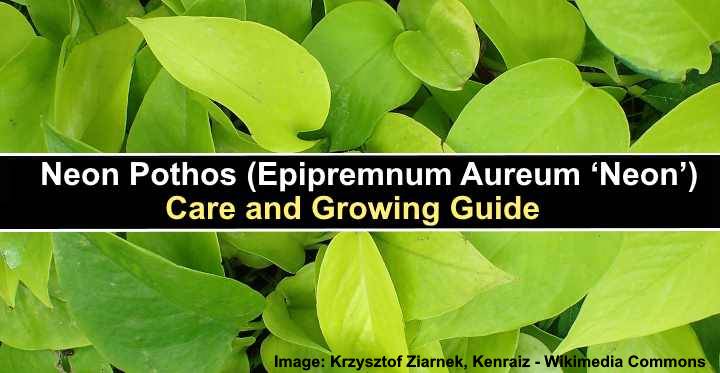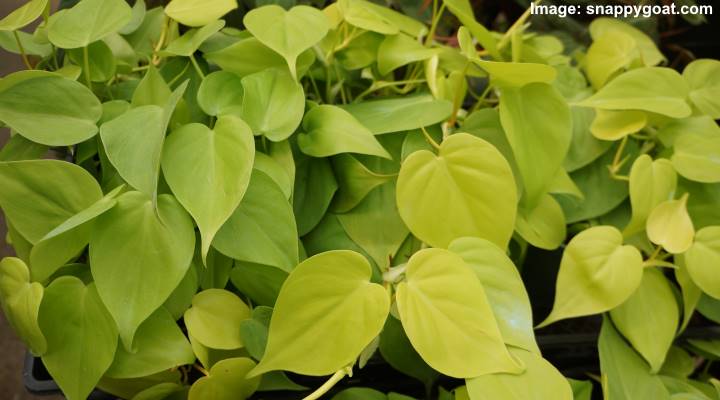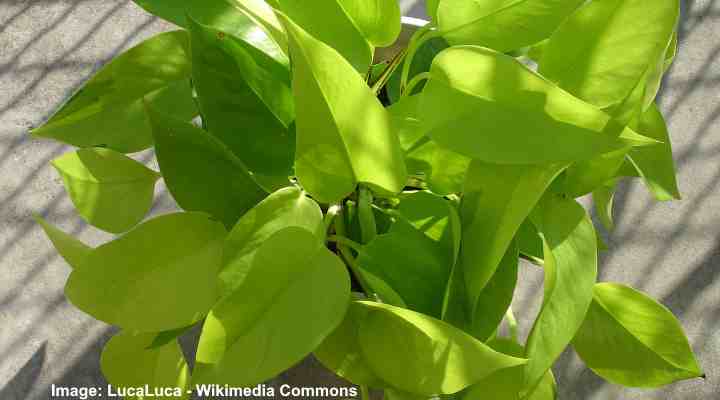Neon Pothos: Plant Care and Growing Guide (Pictures) – Including Variegated Neon Pothos

Neon Pothos (Epipremnum aureum ‘Neon’) is a beautiful tropical evergreen vine with bright lemon-lime green pointed leaves and trailing stems. The ‘Neon Pothos’ is a low-maintenance houseplant that is easy to grow indoors. Its colorful chartreuse foliage thrives under most conditions. Its neon-green leaves cascading over the pot add a tropical touch to the aesthetics of any room.
The ‘Neon Pothos’ is just one cultivar of the many varieties of Pothos houseplants. Other popular vining pothos plants include the ‘Marble Queen,’ ‘Golden Pothos,’ and ‘Silver Satin Pothos.’
This article is a complete guide to caring for a ‘Neon Pothos’ houseplant. At the end of the article, you’ll find helpful tips on how to ensure that its lime-green leaves thrive on trailing vines of a ‘Neon Pothos.’
How to Care for Neon Pothos
To care for a ‘Neon Pothos,’ grow the vining tropical plant in bright indirect light and a loose well-draining potting mix. Water the ‘Neon Pothos’ when the soil partially dries and keep humidity high so that the plant thrives. Lime-green pothos plants grow best in temperatures between 65°F and 85°F (18°C – 29°C).
What Is Neon Pothos (Epipremnum aureum ‘Neon’)

Neon Pothos (Epipremnum aureum ‘Neon’)
‘Neon Pothos’ is a species of flowering plant in the genus Epipremnum and family Araceae. The main characteristic of the ‘Neon Pothos’ is its bright chartreuse, heart-shaped leaves. The lime-green leaves grow on vining stems and usually reach between 6 and 10 ft. (1.8 – 3 m) indoors.
‘Neon Pothos’ produces flowers like all types of arum plants. The creamy-white flowers consist of a flowering spike (spadix) and a bract or spathe. However, it’s rare for any kind of pothos plant to bloom indoors. But the brightly-colored pointed leaves of the ‘Neon Pothos’ make up for any lack of flowers.
Many other features make the ‘Neon Pothos’ such a desirable houseplant. For example, its trailing vines and easy-care nature make it an ideal plant for hanging baskets.
Also, there is evidence suggesting the cultivars in the Epipremnum aureum plant species help clean the air. According to some studies, species of Pothos plants help reduce potentially harmful airborne chemicals.
Another growth characteristic of an easy-care ‘Neon Pothos’ is that it survives well in low-light, and humid conditions. This feature makes ‘Neon Pothos’ plants ideal for growing in bathrooms and kitchens. Also, it’s one of the best bedroom plants – bedrooms typically have less light than other rooms in the house.
Variegated Neon Pothos
A stunning type of ‘Neon Pothos’ is the variegated cultivar. The variegated ‘Neon Pothos’ has pointed heart-shaped leaves with bright yellow and lime-green coloring. The brightly-colored yellow and green leaves need a bit more sunlight than a typical ‘Neon Pothos.’ However, this variegated ‘Neon Pothos’ is easy to care for like the standard chartreuse variety.
Neon Pothos vs. Lemon Lime Philodendron

Philodendron ‘Lemon Lime’ leaves (in the picture) are rounder and broader and look more like heart shape rather than the elongated leaves of Neon Photos
There can be confusion between the lemon-lime philodendron and the ‘Neon Pothos.’ Both pothos and vining philodendron plants have similar growth requirements and look alike.
Both the ‘Neon Pothos’ and ‘Lemon-Lime Philodendron’ have heart-shaped leaves. But comparing the two, you’ll see that the base of pothos leaves is flatter and less rounded than philodendron leaves. Additionally, philodendron leaves are broader and look more like a heart shape. Pothos leaves tend to be more elongated.

Neon Photos leaves (in this picture) are narrower and elongated compared to Philodendron ‘Lemon Lime’
You will also notice that comparing the leaves, ‘Neon Pothos’ has thicker leaves than ‘Lemon-Lime Philodendron’ leaves.
Neon Pothos Care Guide
Neon Pothos’ is a popular houseplant due to its low maintenance and minimal care requirements. This pothos cultivar thrives indoors in most conditions. However, it’s still necessary to care appropriately for the ‘Neon Pothos.’ Here is a guide to pothos plant care.
Where to Grow Neon Pothos?
‘Neon Pothos’ is a versatile plant that grows well in most rooms of your house. Due to its trailing stems and bright lime-green leaves, you can grow a ‘Neon Pothos’ as an easy-care hanging basket plant. The vining plant performs well in bathrooms, kitchens, and shaded corners of almost any room.
‘Neon Pothos’ also has a compact growth habit. With regular pruning, you can have a beautiful tropical table-top plant. Because this pothos has minimal light requirements, it makes an ideal office plant and thrives under artificial lights.
Neon Pothos Light Requirements
‘Neon Pothos’ grows best in bright light but protected from direct sunlight. Getting enough light helps the pothos plant keep its light green foliage and attractive chartreuse hue. ‘Neon Pothos’ plants can also survive in low light or growing in shaded areas.
It’s good to remember that direct, intense sunlight can easily scorch the leaves. Overexposure to the sun can result in pothos leaves becoming pale and yellow or starting to curl.
A neon pothos plant needs about six hours of indirect light a day to thrive. If the lemon lime pothos is near a south-facing or west-facing window, then it’s a good idea to protect it behind a sheer curtain. You can place the hanging basket or pothos pot near an east-facing or north-facing window so that it gets enough light.
Although ‘Neon Pothos’ is a low-light plant, the lemon-lime leaves become darker. You’ll also notice that the plant’s growth will become slow, new leaves are smaller, and the plant starts to resemble a dark-leaved pothos plant.
Variegated ‘Neon Pothos’ plants perform better in bright light rather than continual shade. The light helps keep the yellow and lime-green variegation vibrant and healthy.
The Best Soil for Neon Pothos
Grow ‘Neon Pothos’ houseplants in a fertile, aerated, well-draining potting mix. Combine one part houseplant soil, one part peat moss, and one part perlite. This pothos soil mix provides nutrients, retains some moisture, and helps excess water drain fast—essential elements of pothos plant care.
Pothos plants, including the ‘Neon Pothos,’ don’t grow well in compacted, heavy, soggy soil. Amending the soil with gravel, charcoal bits, or perlite helps improve drainage. Peat moss is also excellent for DIY plant soil recipes because it’s light, adds nutrients, and helps keep the roots moist.
You can also grow neon pothos in water, without any soil. Place a few pothos stem cuttings in a vase of clean water, ensuring that one or two nodes are covered by water. Put the pothos ‘water plant’ in bright, indirect sunlight where it should grow well and develop plenty of roots.
The only care a ‘water pothos’ needs is replacing the water every two weeks and applying fertilizer once a month.
How to Water Neon Pothos Houseplants
Water a ‘Neon Pothos’ plant indoors as often as the top layer of soil dries. To know when it’s time to water the pothos, make sure the top 1” to 2” (2.5 – 5 cm) of soil is dry. If so, soak the potting soil until water drains from the drainage holes.
It may be necessary to water a ‘Neon Pothos’ as often as once a week during summer. In winter, the lime-green pothos needs less watering. However, always let soil moisture be your guide on how often to water a pothos.
It’s good to remember that several factors affect how many times a week you water a pothos plant. For example, hot weather causes moisture to evaporate faster. Also, potting soil in terracotta pots tends to dry out more quickly than in plastic pots.
Here are a few handy tips on watering a ‘Neon Pothos’ vine:
- Use filtered water at room temperature
- Use the drench and dry method to water pothos plants
- Only water a pothos when one-third of the soil is dry
Related reading: How to water houseplants.
Temperature Needs for Growing Lemon Lime Pothos Indoors
‘Neon Pothos’ plants thrive in average room temperatures. Keep the potted pothos in even temperatures of 65°F to 85°F (18°C – 29°C). The minimum nighttime temperature is 60°F (15.5°C). ‘Neon Pothos’ plants grow faster in warmer temperatures. If the air is too cold, the leaves of ‘’Neon Pothos’ can start turning black.
The best care for a ‘Neon Pothos’ means keeping it away from sudden temperature fluctuations. In wintertime, keep the potted ‘Neon Pothos’ away from cold drafts or hot radiators. In summer, make sure the trailing vine isn’t standing in the air-conditioning flow.
Humidity Requirements for Neon Pothos
Lime-green pothos plants thrive in high humidity. However, the adaptable houseplants will survive in the relatively dry air of most homes. To increase air moisture and keep growth healthy, place the pothos pot on a pebble tray half filled with water. A sign of too little humidity is brown tips on the lemon-lime pothos leaves.
There is no need to mist ‘Neon Pothos’ leaves for humidity. Wiping with a damp cloth once a week helps to clean the leaves and increase moisture slightly. If you think that the pothos is suffering from dry air, move it to a more humid room such as a bathroom or kitchen. Or you could group your houseplants together to create a more humid atmosphere.
Neon Pothos Growth Rate
‘Neon Pothos’ is a relatively fast-growing vining plant. The pothos grows fastest in warm conditions and bright indirect sunshine. Usually, pothos plant growth slows down in cooler temperatures and shaded conditions.
Growing indoors, you can expect ‘Neon Pothos’ leafy vines to reach between 6 and 10 ft. (1.8 – 3 m) long. However, it may take a few years for this vining plant to reach maturity.
How to Fertilize Lemon Lime Pothos
Lemon-lime ‘Neon Pothos’ plants don’t require much fertilizing because they aren’t heavy feeders. You can apply a diluted houseplant fertilizer every two months to ensure rapid growth. However, most pothos plants grow well without additional nutrients.
If you decide to fertilize a ‘Neon Pothos,’ remember only to use a diluted solution during the growing season. It would be best if you held off applying fertilizer during fall and winter.
How to Prune Neon Pothos
Pruning a ‘Neon Pothos’ in spring encourages bushy, healthy growth and gives you cuttings for propagation. To prune a lime-green pothos, snip the stems above the leaves and just below the node. This pothos pruning method ensures that new vines grow from the stem nodes. You can also pinch back new stems to encourage bushy growth.
Pruning ‘Neon Pothos’ vines is vital if they become too leggy. Long stems with sparse foliage are usually the result of the plants growing in dark conditions. You can also remove any dead stems, discolored leaves, or dying foliage.
Neon Pothos Propagation Guide
It is easy to propagate ‘Neon Pothos’ using stem cuttings. Cut a 6-inch (15-cm) length of the stem just below a node. Remove the leaves nearest the node. Put the cut stem in a jar of water, making sure that no leaves are in the water. After a few weeks, roots should appear. Plant the rooted stem in fresh potting soil to grow a new pothos plant.
Because of their fast growth, there are plenty of opportunities to cut stems for propagation.
Top care tip when growing ‘Neon Pothos’: To develop a bushy lime-green pothos plant, you can replant the rooted stem cuttings back in the same pot.
How to Repot Neon Pothos
Repot a ‘Neon Pothos’ every two to three years by removing the root ball from the existing pot. Then remove excess dirt from the roots and check for any signs of decay. Pick a container one size larger than the previous one and half-fill with potting soil. Put the plant in the new pot and fill the remaining space.
Repotting a ‘Neon Pothos’ encourages healthy growth. Fresh potting soil helps to replenish nutrients and prevent soil compaction. Additionally, the larger pot gives the roots more room to grow.
Signs you need to repot a lemon-lime pothos are roots poking out from the pot and water pooling on the soil’s surface.
Pests Affecting Neon Pothos Growth
Common houseplant pests rarely affect ‘Neon Pothos.’ The most common pests on lime-green pothos are mealybugs and scale insects. To get rid of these bugs, spray a neem oil solution on the leaves once a week. This natural pesticide kills off pests on houseplants by disrupting their growth habits.
To make a neem oil DIY pesticide, combine 2 tsp. neem oil, 1 tsp. dish soap, and 1 quart (1 l) of warm water in a spray bottle. Mix thoroughly. Use the neem oil weekly by spraying on all parts of the plant’s foliage and stems.
Diseases Affecting Neon Pothos Growth
The most common disease affecting ‘Neon Pothos’ is root rot caused by overwatering. Like most houseplants, pothos doesn’t grow well in soggy, overly-damp soil. The excess moisture causes roots to decay and rot, leading to fungal leaf infections, black leaf spots, and mushy stems.
To prevent diseases from affecting ‘Neon Pothos’ houseplants, always water the plant correctly. This means waiting until the potting soil is one-third dry, then saturating the soil to hydrate the roots.
Is Neon Pothos Toxic?
‘Neon Pothos’ (Epipremnum aureum) is poisonous to dogs and cats. The ASPCA says that plants in the family Araceae contain insoluble calcium oxalates. Cats, dogs, or other animals ingesting these toxins can show signs of oral irritation—burning mouth, drooling, tongue swelling. In some cases, vomiting and difficulty swallowing can also occur.
Neon Pothos (Epipremnum aureum ‘Neon’) Care – FAQs
The beauty of the ‘Neon Pothos’ is that it’s easy to care for indoors. Its other common name—devil’s ivy—comes from the fact that it’s almost impossible to kill. However, there are a few reasons why your ‘indestructible’ pothos could look like it’s under stress.
Why are my ‘Neon Pothos’ leaves turning brown?
‘Neon Pothos’ brown tips are usually an indication of dry air. Pothos plants typically need medium to high humidity to thrive indoors. To resolve the problem of pothos leaves turning brown, move the plant to a more humid location. Or, put the pothos pot on a pebble tray with some water in it.
‘Neon Pothos’ leaves are turning black, what does that mean?
Black ‘Neon Pothos’ leaves are usually a sign of overwatering or very low temperatures. However, other reasons for pothos leaves turning black are too much fertilizer or an insect attack.
To resolve the problem of black pothos leaves, check your watering schedule, making sure the soil dries between waterings. Also, hold off fertilizing to prevent buildup of mineral salts.
What does it mean if ‘Neon Pothos’ leaves are turning yellow?
Too much light exposure is the most common reason pothos leaves turn yellow. Direct sunlight bleaches the lime-green pothos leaves, causing them to look pale and unappealing. Try moving the plant to a shadier spot to prevent more pothos leaves from turning yellow.
What are black spots on lime green pothos?
Black spots on a pothos plant usually indicate a fungal infection. The most common cause of dark brown or black leaf spotting is overwatering. To resolve this problem, prune the spotted leaves and stems, repot the ‘Neon Pothos’ and remove any diseased roots. Then plant the pothos in fresh, moist potting soil.
My ‘Neon Pothos’ plant leaves are curling, what should I do?
Pothos plant leaves can often curl because they lack moisture or humidity. The leaf curling is the pothos plant is a way of preventing more moisture loss. However, if the soil is moist, the pothos plant leaf curling could be the result of excessive light or moisture. So, it’s a good idea to check that your ‘Neon Pothos’ is getting the proper care.
Related articles:
- The Best Indoor Vine Plants and Climbers
- Easy to Care for Indoor Hanging Plants
- Types of Pothos Plants (Epipremnum Aureum)
